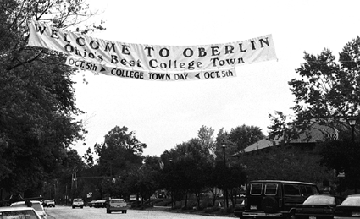








A panel of townspeople and College faculty and staff discussed the relationship between the town of Oberlin and the College on Monday. The panel discussion came after Oberlin was named Ohio's best college town by Ohio Magazine and before a celebration of that award this Saturday as part of Town-College Day.
The discussion revealed that the open relationship lauded in the Ohio Magazine article is arguable. The article called Oberlin a "permeable campus" where, "there is much intermingling between students and townspeople."

But in reality the relationship between the College and town is a multi-faceted one that can seem warm sometimes and decidedly cool at other times.
"The town of Oberlin itself is a rather conservative town," said Francine Todd, Oberlin School District's People Services director. "But the town does rely on the College for its livelihood ... There are so many common values we all hold."
Some students don't feel such a connection with the town. Glenn Kaplan, sophomore, said, "I feel absolutely no affiliation with `townies.' I hardly ever see them, and when I do we don't have that much to say to each other."
Daniel Gardner, director of the Center for Service and Learning, was also on the panel Monday night. He said that both the College and the town often "have a critical view of each other."
Gardner said, "The prevailing view of people in town is that if you don't grow corn, you work in the steel mill." And town residents stereotypically think that students are "all lesbians and they shave their hair," Gardner said.
However, Professor of Sociology James Walsh heartily disagreed. Walsh, who also serves as the Oberlin City Prosecutor, said, "The view of the College is far warmer than the townspeople are given credit for."
He also said, "It is the responsibility of the College to be a part of the community. One of the nicest things about the presidency of Nancy Dye is that she has given students an opportunity to reach out into the community."
Dana Brooks, a sophomore, said, "The College is my environment." But she added, "You can get into the community if you try. I know the Center for Service and Learning runs service projects and things like that."
Gardner said that among some citizens "there is some sentiment that the College is making tax rates higher because it is a non-profit organization. This is a very small but very real population."
Corrina Steward, who transferred to Oberlin from the University of Rochester, talked about going into the town. "I don't feel like I'm going into a separate community when I go into town, I feel like its an extension of the campus," she said.
Another student at the panel said, "I feel very good going into the community. I think there are a lot of people who are not prejudiced against students."
According to Gardner, 800 students were involved in organizations that did work in and around the community last year. Those that were involved in one-time service events was nearly 1,000.
The College has helped the community in other ways in the recent past, including paying for a large part of the bill for a municipal library. Also, the Oberlin College class of 1996 established a scholarship for an Oberlin High school student to attend Oberlin College.
Within the city limits of Oberlin, 51 percent of the land belongs to the College and is not taxable because of its non-profit status.
Banner days: The sign of Oberlin's newly awarded status was hung in preparation for the weekend and the events occuring throughout Friday, Staurday and Sunday(photo by Stefanie Ramsden)

Copyright © 1996, The Oberlin Review.
Volume 125, Number 5; October 4, 1996
Contact Review webmaster with suggestions or comments at ocreview@www.oberlin.edu.
Contact Review editorial staff at oreview@oberlin.edu.